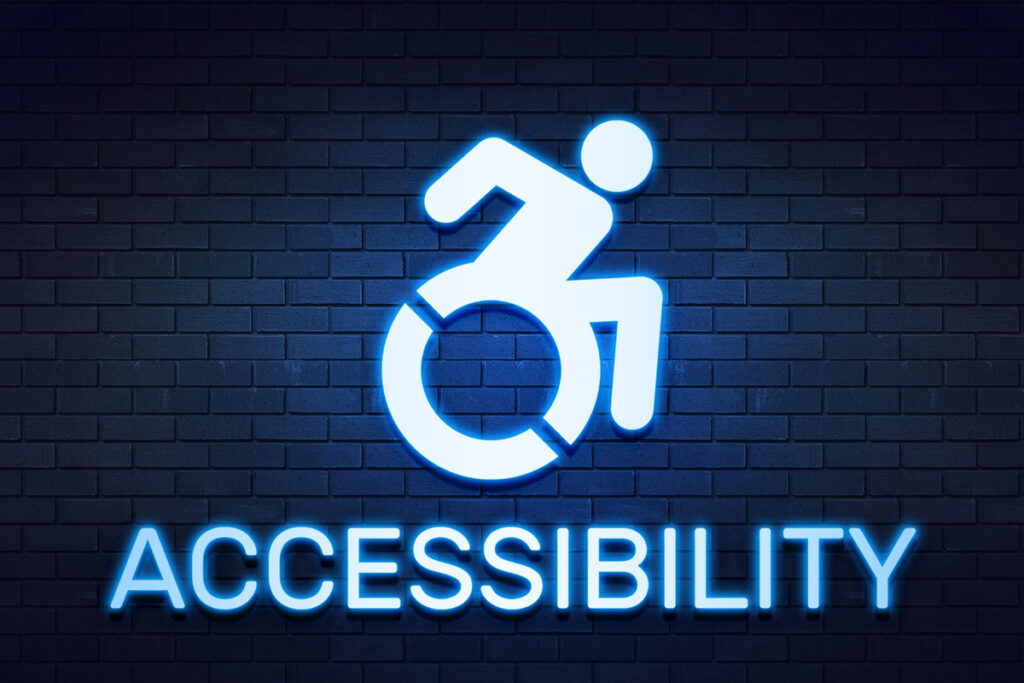
In the multifaceted domain of SEO, where the spotlight often shines brightest on keywords, backlinks, and content strategy, there lies an aspect just as pivotal, yet not as frequently discussed, website accessibility. Drawing on my extensive experience in the field of SEO, I’ve witnessed firsthand the significant, often undervalued, impact of accessibility on a website’s performance both in terms of its reach and its standing in search engine rankings.
Accessibility in web design is more than an ethical consideration or compliance requirement, it’s a strategic element that smartly aligns with SEO objectives. We aim to illuminate how enhancing your website to be accessible to all users transcends the noble cause of inclusivity. It’s a move that can transform your site’s SEO performance, broadening your audience while simultaneously aligning with the algorithms that dictate search engine rankings.

We’ll look into the essential best practices for accessibility in web design, detailing how these practices not only cater to a wider audience but also how they interplay with the core principles of SEO. From understanding the importance of alt text for images to grasping the necessity of easy navigation and readable fonts, we’ll explore how these elements contribute to both a site’s accessibility and its SEO success.
Join me as we proceed through this less-trodden path in SEO, unraveling how the principles of accessibility intertwine with the strategies for search engine optimization. Whether you’re a web developer, a content creator, or a business owner, this exploration will equip you with the knowledge to make your website not only more inclusive but also more visible and effective in today’s competitive digital landscape.
Understanding Web Accessibility
Web accessibility is a critical aspect of web design, ensuring that all users, including those with disabilities, can access and interact with websites effectively. This involves designing websites with various impairments in mind, such as visual, auditory, motor, and cognitive challenges. For example, visually impaired users might rely on screen readers, so it’s important for web content to be structured in a way that is compatible with these tools. Similarly, ensuring websites are navigable through keyboard-only commands can significantly benefit users with motor impairments. By considering these diverse needs, web accessibility not only opens up the internet to a wider audience but also demonstrates inclusivity and consideration for all users.

SEO Benefits of an Accessible Website
Improved User Experience
Improving the user experience is a fundamental benefit of accessible web design. When a website is accessible, it becomes easier to use for everyone, not just individuals with disabilities. This enhanced usability can lead to a more positive experience for all visitors. Search engines, particularly Google, prioritize and reward websites that offer a good user experience. Websites that are easy to navigate, understand, and interact with are likely to have lower bounce rates and higher engagement levels, which are key indicators that search engines use to gauge the quality of a site. Consequently, these factors can lead to improved search engine rankings, making accessibility not just a matter of inclusivity but also a strategic SEO decision.
Increased Site Usability
Increasing a site’s usability through accessibility measures positively impacts its SEO performance. When a website is designed with accessibility in mind, it often results in clearer navigation, more organized content structure, and simpler user interfaces. These elements not only make the site more navigable for individuals with disabilities but also improve the overall user experience for all visitors. Search engines evaluate and favor websites that are user-friendly, as they are more likely to satisfy user queries effectively. Therefore, by enhancing site usability with accessible design, you are indirectly boosting the website’s search engine ranking potential. This is because search engines aim to provide the best possible results to users, and a site that is easy to use and understand is more likely to be ranked higher.
Enhanced Reach
Enhancing the reach of your website through accessibility practices significantly benefits SEO. When a site is accessible, it caters to a wider audience, including those with disabilities. This inclusivity often leads to an increase in traffic, as more users can effectively interact with and navigate the website. Higher traffic typically results in improved engagement metrics such as increased time on site and lower bounce rates. These positive user interactions signal to search engines that your site is valuable and relevant, potentially leading to higher search rankings. Additionally, an accessible website can garner attention from various groups and communities, further expanding its reach and influence, which is beneficial for SEO.

Best Practices for Creating Accessible Websites
Use Descriptive Alt Text for Images
Using descriptive alt text for images is an essential practice in web design for both accessibility and SEO. Alt text provides a textual alternative to images for users who are visually impaired, using screen readers to access web content. This accessibility feature ensures that all users, regardless of visual ability, can understand the content presented in images.
From an SEO perspective, alt text plays a significant role. It allows search engines to better index and understand the images on your site, contributing to improved image search rankings. When crafting alt text, it’s important to be both descriptive and concise, accurately depicting the image’s content or function while incorporating relevant keywords where appropriate. This practice can enhance the overall SEO of your website by making it more discoverable in image searches, thus driving additional traffic to your site.
Additionally, well-written alt text can contribute to the contextual relevance of the webpage, further boosting the page’s SEO value. It’s a simple yet effective way to make your website more inclusive and search engine friendly.

Ensure Text is Readable and Understandable
Ensuring that text is readable and understandable on a website is crucial for both accessibility and SEO. This involves using clear, straightforward language and selecting font types and sizes that are easy to read. Additionally, maintaining high contrast between text and background colors is essential for users with visual impairments, including those with color blindness or low vision.
High contrast not only aids those with visual impairments but also improves the overall readability of the content for all users. This approach can significantly enhance the user experience, making your website more engaging and easier to navigate. From an SEO perspective, readable and understandable text can reduce bounce rates and increase time spent on the site, signaling to search engines that your content is valuable and relevant. This practice aligns with the goal of creating an inclusive digital environment while also optimizing your website for better search engine rankings.

Create Keyboard-Navigable Websites
Creating a website that is navigable using only a keyboard is a key aspect of web accessibility, particularly for users with certain motor disabilities who may not be able to use a mouse. This aspect of web design involves ensuring that all interactive elements, such as links, buttons, and forms, can be accessed and used through keyboard inputs alone.
When a website is fully keyboard-navigable, it not only becomes more accessible to a wider range of users but also tends to have a better structure and organization. This improved usability can lead to a more positive user experience for all visitors, which is a factor that search engines consider when ranking websites. Implementing keyboard navigation supports the inclusive design of a website and can indirectly contribute to better SEO by making the site more user-friendly and engaging. This approach is not just about compliance with accessibility standards; it’s about enhancing the overall functionality and appeal of the website.
Include Transcripts and Subtitles for Audio and Video Content
Including transcripts and subtitles for audio and video content on your website is an essential practice for ensuring accessibility, especially for users with hearing impairments. By providing written versions of multimedia content, you enable users who are deaf or hard of hearing to access the same information as those who can hear the audio.
Beyond accessibility, transcripts and subtitles have the added benefit of enhancing your website’s SEO. Search engines cannot ‘listen’ to audio or ‘watch’ videos, but they can crawl text content. By adding transcripts and subtitles, you provide additional text for search engines to index, which can improve your site’s visibility in search results. This practice enriches your content with relevant keywords and phrases, potentially driving more traffic to your site. It’s a clear example of how prioritizing accessibility can have a direct, positive impact on your SEO efforts.

Design Forms for Accessibility
Designing forms with accessibility in mind involves creating interfaces that are usable for everyone, including people with disabilities. This includes labeling form elements clearly so users can understand what information is needed and where to input it. Providing clear instructions for each form field is also crucial, as it guides users through the process, especially those who may rely on screen readers or other assistive technologies.
Accessible forms improve the overall user experience, as they are easier to understand and navigate. This is beneficial not only for users with disabilities but for all users, as it can reduce confusion and errors, leading to a more efficient and satisfying interaction with your website. By ensuring your forms are accessible, you cater to a wider audience and foster an inclusive digital environment. This approach not only aligns with best practices for web design but also reinforces the positive image of your brand as one that values and respects all users.
Responsive and Adaptive Design
Responsive and adaptive design are critical in creating a website that is accessible to all users, including those with disabilities. Responsive design ensures that your website adjusts seamlessly to different screen sizes and devices, providing an optimal viewing experience whether on a desktop, tablet, or smartphone. This adaptability is essential not only for user convenience but also for accessibility, as it allows users with disabilities to access your content in a way that suits their needs.
Adaptive design goes a step further by detecting the user’s device and loading the appropriate version of the site. This approach can offer a more tailored experience for different devices, ensuring that all elements of the site are fully functional and accessible on any device. Both responsive and adaptive designs are key factors in mobile SEO, as search engines prioritize sites that provide a good mobile user experience. By implementing these design strategies, you enhance accessibility for users with disabilities while also improving your site’s overall SEO performance.

Regular Accessibility Audits
Conduct regular audits to identify and fix accessibility issues. Tools like the Web Accessibility Evaluation Tool (WAVE) can be helpful.
As we wrap up our exploration of the synergy between website accessibility and SEO, it’s crucial to recognize that incorporating accessibility into your website design transcends mere compliance with ethical standards. It embodies a strategic and savvy approach in the world of SEO. In my experience navigating the nuances of digital marketing, I’ve consistently seen how accessible websites garner more visibility and success online.
Embracing accessibility is more than just opening your digital doors to a broader audience, it’s about enhancing every aspect of your website’s interaction with both users and search engines. By implementing the best practices of accessibility, you’re not just ticking off a checklist for inclusivity, you’re actively refining your website to be more user-friendly, which in turn, is highly favored by search engines. This consideration leads to improved user experiences, lower bounce rates, and, ultimately, a stronger presence in search engine results.
Think of accessibility as an investment in your website’s future. In the ever-evolving landscape of SEO, where user experience increasingly dictates search rankings, an inclusive approach is not just commendable but also strategic. It positions your website not only as an information resource but as a beacon of user-centric design and functionality.
In closing, remember that the journey to an accessible website is ongoing. It’s about evolving with the needs of your audience and the requirements of search engines. An inclusive approach in SEO is more than a trend, it’s a sustainable practice that reaps long-term rewards. So, as you continue to build and optimize your website, keep accessibility at the forefront of your strategy. It’s a path that leads to not just a more ethical and inclusive web but also to a more visible and successful online presence.

